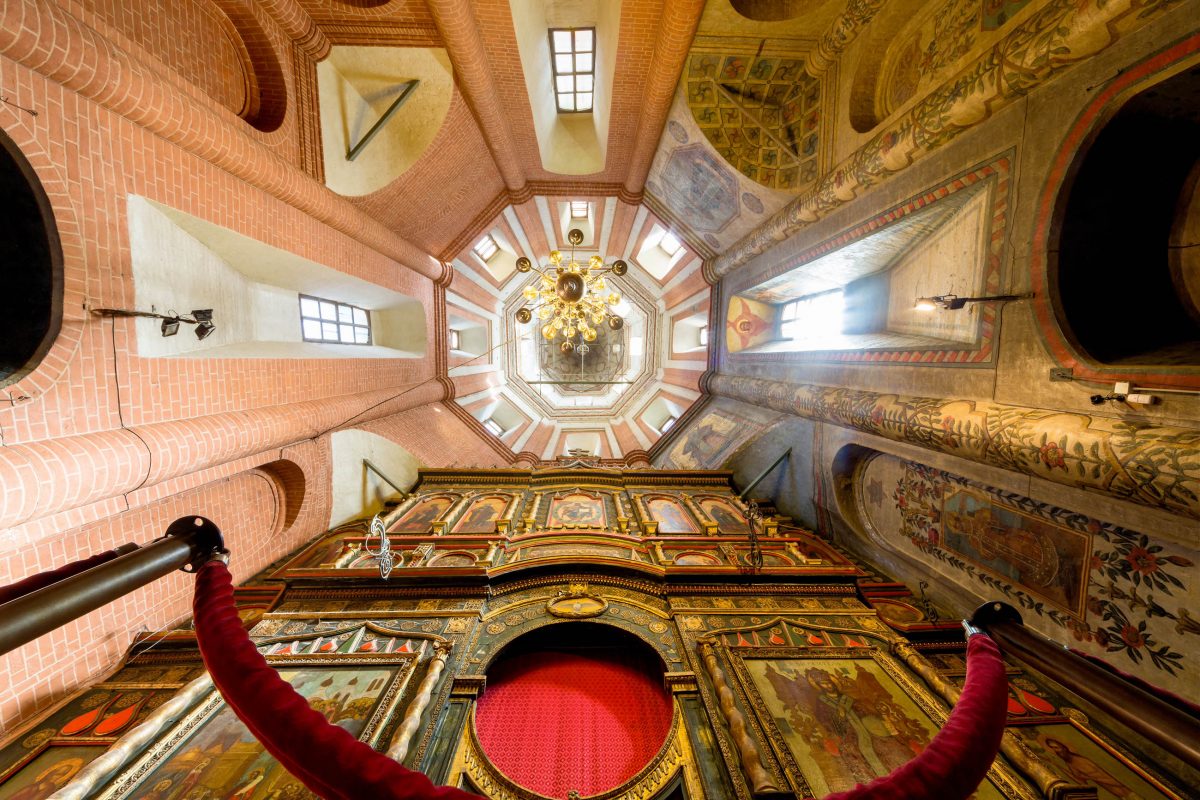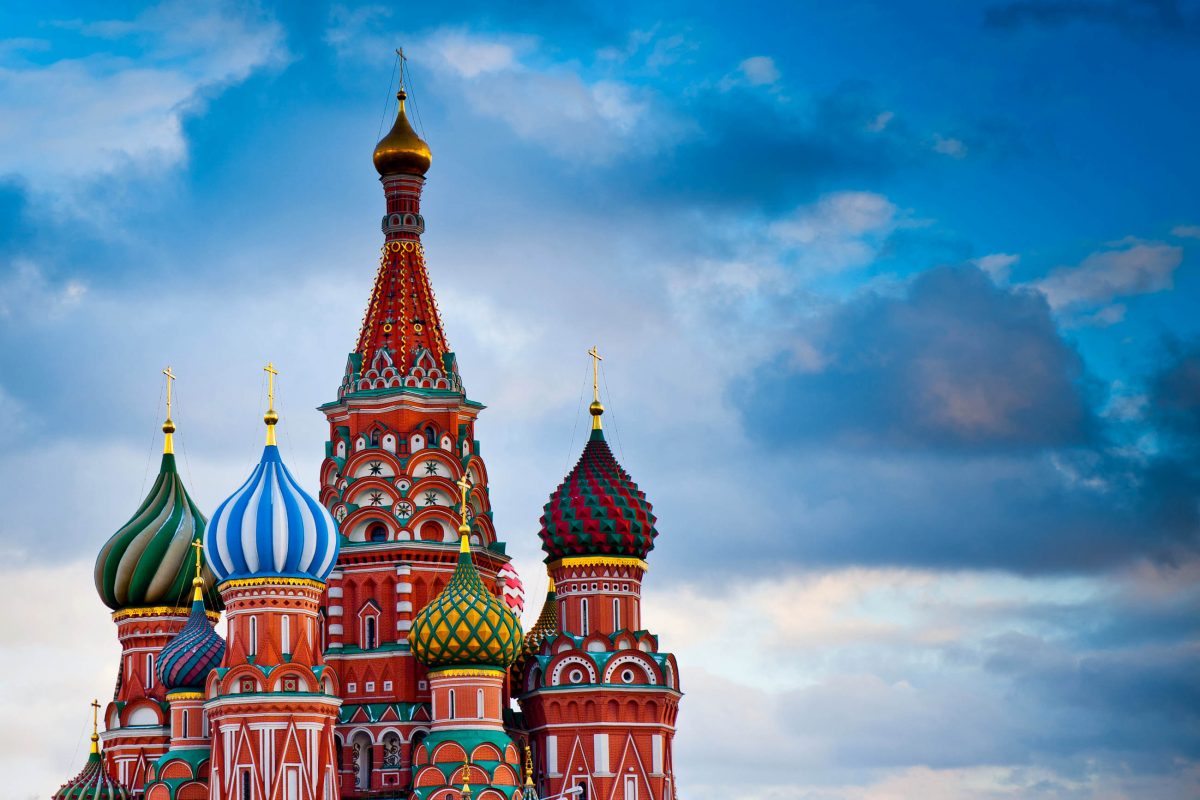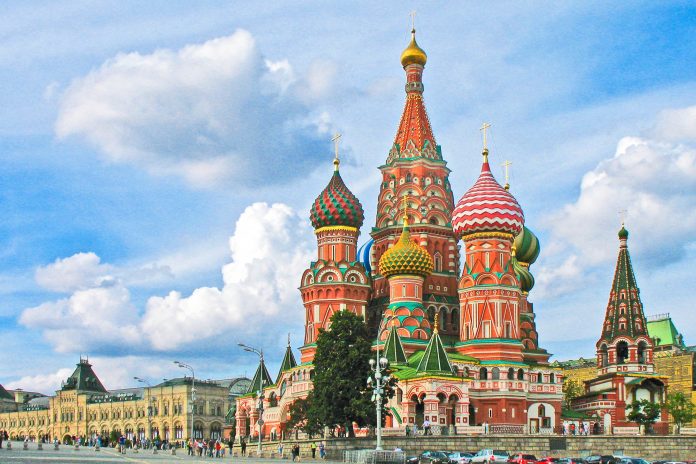Die weltbekannte Basilius-Kathedrale auf dem Roten Platz in Moskau beeindruckt durch ihre farbenprächtige Fassade, die verspielten Zwiebeltürme und ihre einzigartige versteckte Symmetrie.
Die Basilius-Kathedrale in der russischen Hauptstadt Moskau ist das unumstrittene Highlight auf dem weltbekannten Roten Platz. Mit ihrer farbenprächtigen Fassade und den bunten Zwiebeltürmen stellt sie als Wahrzeichen Moskaus ein fantastisches, international bekanntes Postkartenmotiv dar. Seit 1990 zählt sie gemeinsam mit dem Roten Platz und dem Kreml zum Weltkulturerbe der UNESCO und steht auch auf unserer Liste der Top 10 Sehenswürdigkeiten von Russland.
Inhaltsverzeichnis
BILDER: Basilius-Kathedrale in Moskau
Fotogalerie: Basilius Kathedrale in Moskau
Die Basilius-Kathedrale am Südrand des Roten Platzes heißt eigentlich „Pokrowski Sobor Wassilija Blaschennowo“ („Mariä-Schutz-und-Fürbitte-Kathedrale am Graben“). Sie wurde im Jahr 1555 an Stelle der hölzernen Kirche der Heiligen Dreifaltigkeit errichtet, die nur drei Jahre zuvor zu Ehren des Sieges über die Tataren in den Moskauer-Kasan-Kriegen gebaut wurde. Auftraggeber war der berüchtigte Zar Iwan IV., erster Zar Russlands und auch bekannt als „Iwan, der Schreckliche“.
Die Schöpfer der Basilius-Kathedrale
Die Architekten der Basilius-Kathedrale waren Postnik Jakowlew und Barma. Der Legende nach fragte Iwan der Schreckliche nach Fertigstellung der Basilika, ob die beiden Meister noch ein schöneres Bauwerk schaffen könnten. Als sie bejahten, soll er ihnen die Augen ausgestochen haben, damit sie nie wieder etwas Schöneres als die Basilika auf dem Roten Platz kreieren konnten. Diese Geschichte bleibt jedoch eine Legende, denn vier Jahre nach dem Tod des Zaren errichtete Postnik Jakowlew an der Kathedrale die Kapelle des Basilius des Seligen – ein Gottesnarr, nach dem die Kathedrale heute benannt ist.
Chaotische Basilius-Kathedrale?

Auf den ersten Blick erscheint die Basilius-Kathedrale wie ein bunter Wirrwarr aus Rundgängen, Zwiebeltürmen, Treppenaufgängen und Galerien. Sie steht nicht einmal im rechten Winkel zum Roten Platz. Zu ihrer Bauzeit war die gesamte Kathedrale Weiß und ihre neun Kuppeln glänzten alle in Blattgold. Erst im Zuge der Restaurierungen im 16. und 17. Jahrhundert kamen die farbenfrohen Umgestaltungen und asymmetrischen Nebengebäude hinzu.
Eines davon war 1588 die Kapelle über dem Grab des Basilius des Seligen, dem die Kathedrale gewidmet ist. Alle Kuppeln bis auf die des höchsten Turms wurden durch die heute bekannten, bunt gemusterten ersetzt, von denen keine der anderen gleich. Die schneeweißen Wände wurden ziegelrot gestrichen und mit weißen Mustern und Ornamenten verziert.
Tatsächlich: Perfekte Symmetrie

Auch der verwinkelte Innenraum der Basilius-Kathedrale wurde mit zahlreichen Ornamenten reich geschmückt, die Blumenmuster sind Abbildungen des Paradieses. Im Inneren der Basilius-Kathedrale ist ihr symmetrischer Aufbau allerdings deutlich zu sehen. In Wahrheit ist der wunderschöne Sakralbau ein Viereck mit einem aufgesetzten Achteck, das oben in die goldene Kuppel mündet.
Rund um den großen Turm erheben sich vier achteckige Türme in allen Himmelsrichtungen und dazwischen kleine viereckige Türme. Betrachtet man die Basilika von Westen aus, wird diese versteckte Symmetrie auch von außen deutlich.
Kirchen in der Kirche

Absolut einzigartig ist, dass sich unter jeder der neun Kuppeln eine eigene Kirche erstreckt. In der Mitte unter der goldenen Kuppel liegt die ursprüngliche Kirche der Heiligen Dreifaltigkeit. In ihrem Umkreis befinden sich die Kirche des Heiligen Nikolaus des Wundertäters, die Kirche des Einzugs in Jerusalem, die Kirche der Heiligen Cyprian und Justina, die Kirche der Drei Patriarchen von Konstantinopel, die Kirche Alexander Swirskis, die Kirche Warlaam Chutynskis und die Kirche Gregors des Erleuchters. Diese Kirchen stehen für die acht bedeutendsten Schlachten um die tatar-mongolischen Hauptstadt Kasan.
Zerstörungsversuche der Basilius-Kathedrale
Die Basilius-Kathedrale sollte im Lauf der Geschichte mehrmals zerstört werden.
Napoleon soll von der „Christlichen Moschee“ so beeindruckt gewesen sein, dass er sie mit nach Paris nehmen wollte. Als dies nicht funktionierte wollte er sie kurz vor der Flucht der französischen Truppen in die Luft sprengen. Ein plötzlich aufkommender Regen löschte jedoch die Zündschnüre zu den Pulverfässern.
Als 1936 die Kommunisten den Roten Platz umgestalten wollten, war die Basilius-Kathedrale im Weg und sollte abermals abgerissen werden, was jedoch durch Stalin verhindert wurde.
Als es wieder um den Abriss der Kathedrale ging, schloss sich der Architekt und Restaurator Petr Baranowsky im Inneren der Kathedrale ein und meinte, wenn dieses einmalige Bauwerk zerstört werden müsste, wolle er mit in die Luft gesprengt werden. Diese Entschlossenheit zwang selbst die Kommunisten, von ihren Plänen abzusehen.
Und so kann das faszinierende Bauwerk bis heute von aller Welt bewundert werden.
Heute fungiert die Basilius-Kathedrale als Teil des historischen Museums von Moskau und seit dem Zerfall der Sowjetunion im Jahr 1991 werden auch in unregelmäßigen Abständen wieder Messen abgehalten. Neben den fantastischen Fresken und Ikonen, sowie Russlands größter Glockensammlung mit 19 Exemplaren sind in der Basilius-Kathedrale historische Waffen aus der Zeit Iwans des Schrecklichen zu sehen.
Weiterführende Links:





